Electricity And Circuits
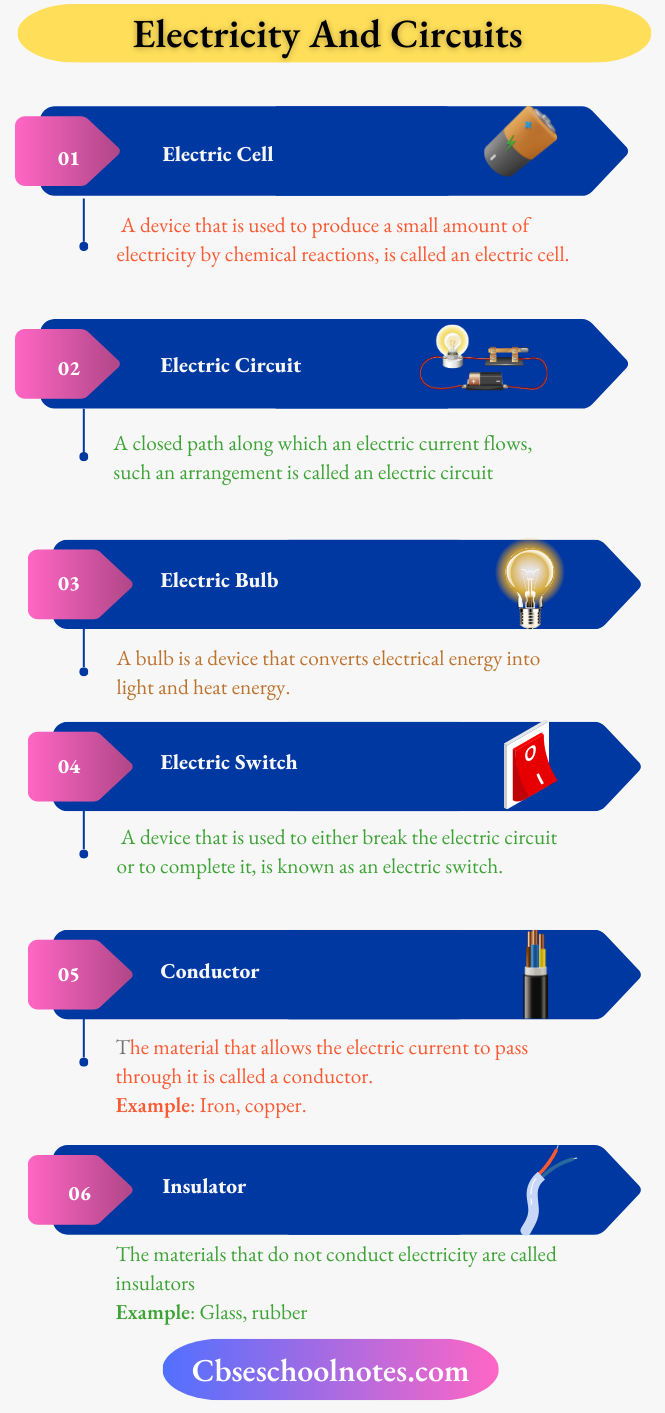
Electricity And Circuits Electric Cell
An electric cell is a device that produces electricity from chemicals stored inside it A device that is used to produce a small amount of electricity by chemical reactions is known as an electric cell.
- There is a wide utilization of these cells such as in alarm clocks, wristwatches, cameras, and many other devices.
- The electric cell produces electricity till the whole of its chemical gets used. When the chemicals inside the cell are exhausted, the cell needs to be replaced by a new one.
Structure of Electric Cell
A common electric cell is a cylindrical cell as shown in

- A metal cap on the upper side, a positive terminal (+)•
- A metal disc on the lower side, a negative terminal (-)
- The chemicals ammonium chloride and zinc chloride present inside between the two terminals are called electrolytes.
Read and Learn More Class 6 Science Notes
Note: Terminal is a point at which either current starts or reaches finally after flowing.
- For current to flow, the positive terminal must be connected to the negative terminal and this polarity must be maintained.
- An electric cell is a single unit but when several electric cells are used together, it is called a battery, which can be used to power bigger devices.
Why should you never connect the positive (+) and negative (-) terminals of the cell directly?
Never join the two terminals of the electric cell without connecting them through a switch and a device like a bulb. If you do so, the chemicals in the electric cell get used up very fast and the cell stops working.
Electric Bulb
A bulb is a device that converts electrical energy into light and heat energy. The electric bulb was invented by Thomas Alva Edison in 1879.
An electrical bulb has the following parts:
- A glass bulb.
- A thin coil of wire inside the glass bulb is called a filament. A bulb glows when an electric current passes through its filament. The filament heats up and glows to give light, filament is made of tungsten material.
- It has two thick wires that provide support to the filament. One wire is connected to the metal case and the other wire is connected to the metal tip.
- The metal tip and the metal case act as two terminals of an electric bulb.
These two terminals do not touch each other and are separated by an insulating material
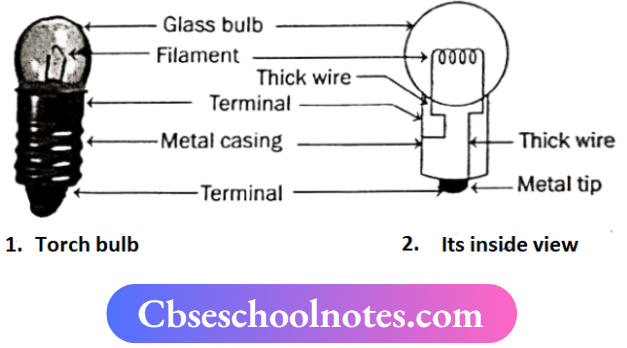
Electric Circuit
A closed path along which the electricity can flow is called an electric circuit. It provides a complete path for electricity to pass (current flow) between two terminals of the electric cell
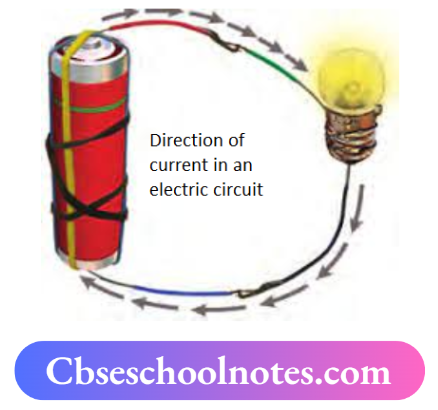
Electric current always flows from the positive to the negative terminal of the cell. The current passes only when the circuit is complete.
Types of circuits are as follows
- Closed Circuit: It is an unbroken path through
which electricity can pass easily. It is a circuit in - Open Circuit: It is a broken path through which electricity cannot pass. It is a circuit in which there is a gap in the connections between the terminals of the cell, wires the bulb, etc
Science Insight
Electric circuits can be classified as series and parallel circuits. In a series circuit, the electric current is the same, but in a parallel circuit, the current may vary. Electric circuits in our home are parallel circuits so that each appliance can take current as per it requirement
Fused Bulb
- A bulb is said to be fused when the filament of a bulb is broken due to overheating.
- A break in the filament of an electric bulb means a break in the path of the current between the terminals of the electric cell. Therefore, no current passes through its filament, and a fused bulb does not glow.
Electric Switch
A simple device -which is used to either break the electric circuit or to complete it, is known as an electric switch or key. The switches used in lighting of electric bulbs and other devices in homes

Electric, which can be used as a lamp. It has two or more two cells, one bulb, and a switch. When the electricity supply fails at home, a torch is used to provide light.
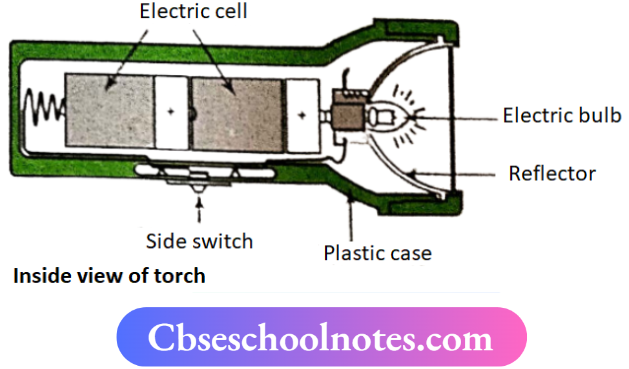
Electric Conductors And Insulators
Electric conductors are those materials that allow electric current to pass through them. c.g. Iron, silver, aluminum, copper, brass, graphite. On the other hand, insulators are those materials that do not conduct electricity and are resistive to the flow of current.
Examples: Rubber, plastic, wood, ceramic, porcelain, asbestos, glass, mica, cotton, jute, thermocol, wax, etc.
All metals are good conductors of electricity, while all non-metals (except carbon) are bad conductors of electricity. Silver is a better conductor of electricity than copper.
Science Insight:
Water conductor or insulator?
Water behaves as both a conductor and an insulator. If water has impurities that help in conducting electricity, then it behaves like a conductor. On the other hand, if we use distilled water where no impurities are present, it behaves like an insulator.
Importance of Conductors and Insulators
- Conductors and insulators are equally important to us.
- Switches, electrical plugs, and sockets are made of conductors.
- On the other hand, insulators like rubber and plastic are used for covering electrical wires, plugs, tops, switches, and other parts of electrical appliances that people might touch.
Note: Your body is a conductor of electricity. Therefore, be careful when you handle an electrical appliance.

Activity 1
Aim:
To observe and study the working of torch bulbs.
Material Required: A torch, and a magnifying glass.
Procedure
- Take a torch and look inside its bulb by magnifying glass. You can also take out the bulb with the help of a teacher.
- You will find a thin wire fixed in the middle of the glass bulb, as shown in the figure.
- Now, switch ON the torch and observe the part of the bulb which is glowing
Conclusion:
We have observed that the thin wire in an electric bulb that produces light is known as the filament of the bulb
Activity 2
Aim:
To demonstrate the right connection of bulb and cell.
Material Required:
Four colored wires, a cell, and a bulb.
Procedure:
- First, remove the plastic covering of each end of the wire.
- Try to make connections as shown in the observation table.
- Observe, whether the bulb glows or not, in each connection
Observation Table

Conclusion
We have concluded from the above observation that (f) bulbs will glow because the circuit is complete and in other cases, bulbs will not glow because the circuit is incomplete
Activity 3
Aim:
To make a bulb light up using an electric cell.
Material Required:
A torch bulb, an electric cell, and a wire (with ends exposed or naked)
Procedure:
- Join one end of the electric wire around the base electric bulb and leave the other end free.
- Fix the tip of the base of the torch bulb with the positive terminal of the electric cell.
- Bring the tip of the free end of the electric wire in contact with the negative terminal of the electric cell. We will find that the torch bulb starts glowing.
- Remove the electric bulb away from the positive terminal of the electric cell. We notice that the bulb stops glowing.
Homemade torch:

Conclusion:
We have noticed that the bulb will glow’ when the circuit is complete but when we remove the bulb from the metal cap, the circuit is incomplete and the bulb goes off
Activity 4
Aim: To make a simple electric switch.
Material Required:
Two drawing pins, a safety pin, electric wires, a bulb, an electric cell, and a piece of thermal.
Procedure:
- Insert a drawing pin into the ring at one end of the safety pin and fix it on the thermal.
- Now, fix the other drawing pin on the thermal sheet in a way that the free end of the safety pin can touch it and attach the piece of wire with the drawing pins.
- Make a circuit by connecting an electric cell and a bulb with the switch.
- Rotate the safety pin, so that its free end touches the other drawing pin. You will find that the bulb starts glowing.
- Now, move the safety pin away from the drawing pin.
You will find that the bulb stops glowing
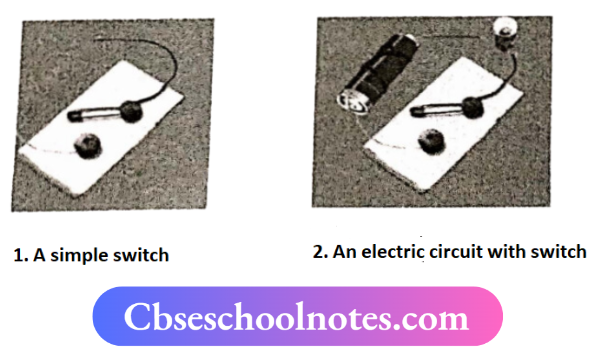
Conclusion:
- We have concluded that, when we touch the free end of the safety pin with the other drawing pin, then the switch is said to be ON. Thus, the bulb starts glowing.
- The bulb does not glow when the safety pin Is not in touch with the other drawing pin
Activity 5
Aim:
To examine whether a given material is a conductor or an insulator.
Material Required:
Key, scale, pins, glass bangle, electric bulb, electric cell, conducting wire.
Procedure:
- Make a conduction tester by connecting an electric cell and bulb with the help of wires
- Collect samples of different types of materials such assets, keys, scales, pins, etc.
- Join the free ends of the wires of your tester with two ends of the samples.
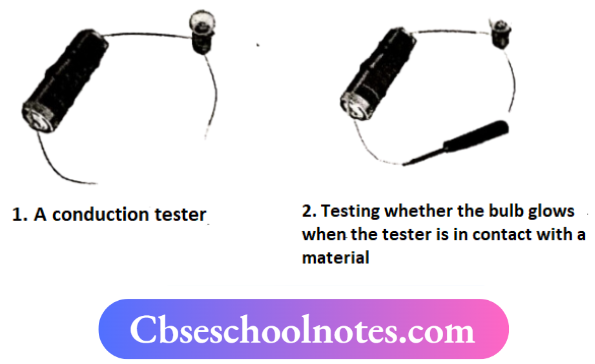
Now make a table of whether the bulb is glowing or not:
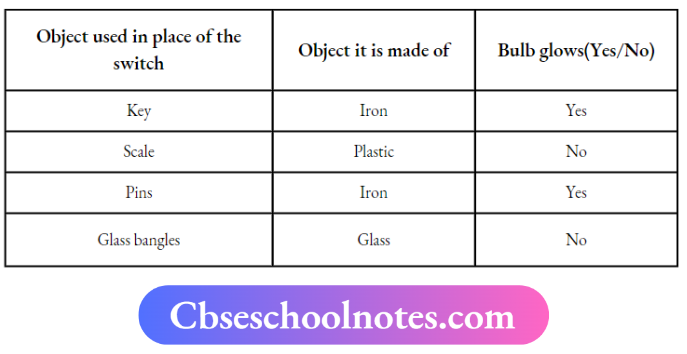
Conclusion:
We have concluded that objects which allow the current to pass through them are conductors, and objects which do not allow the current to pass through them are insulators.
